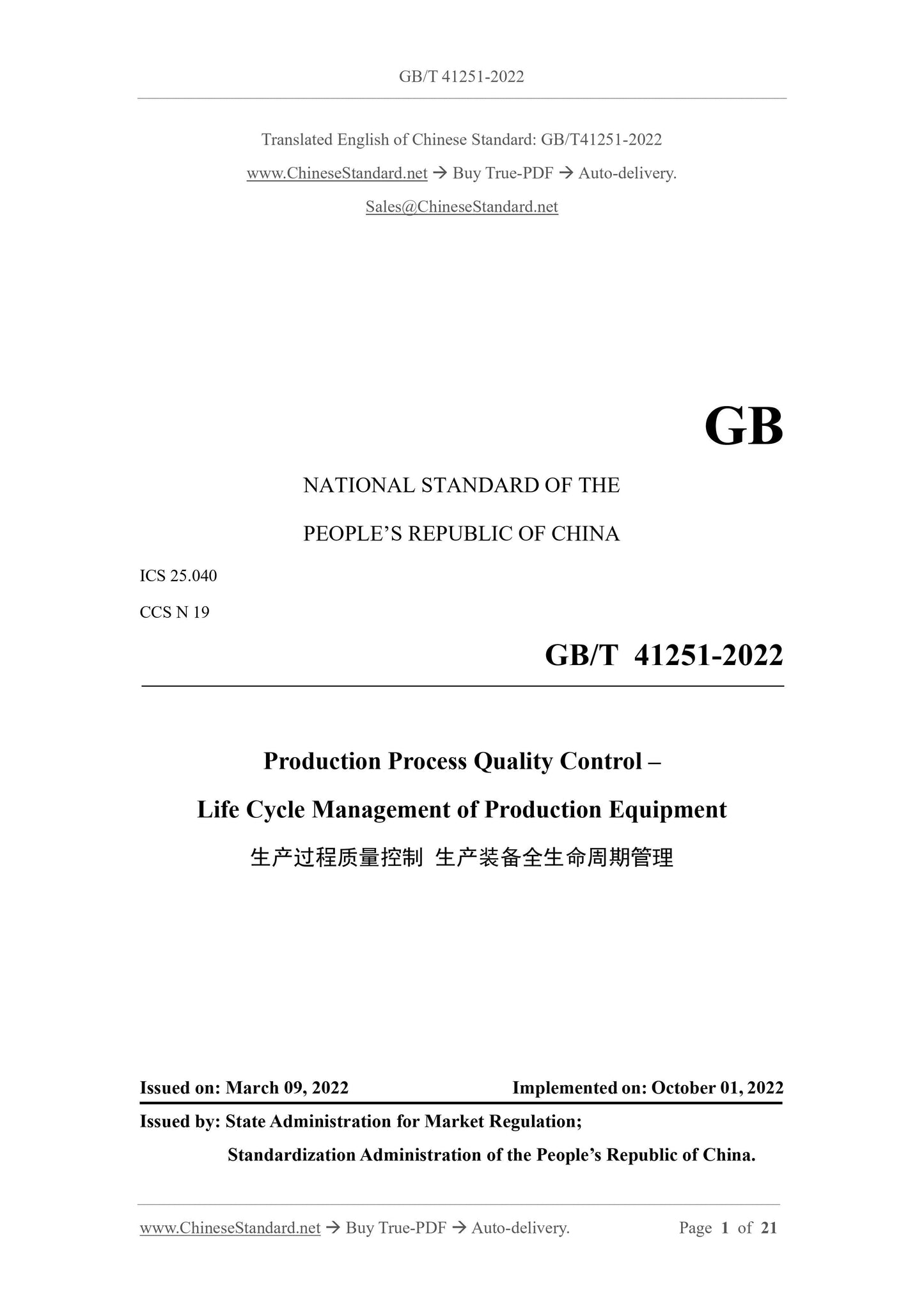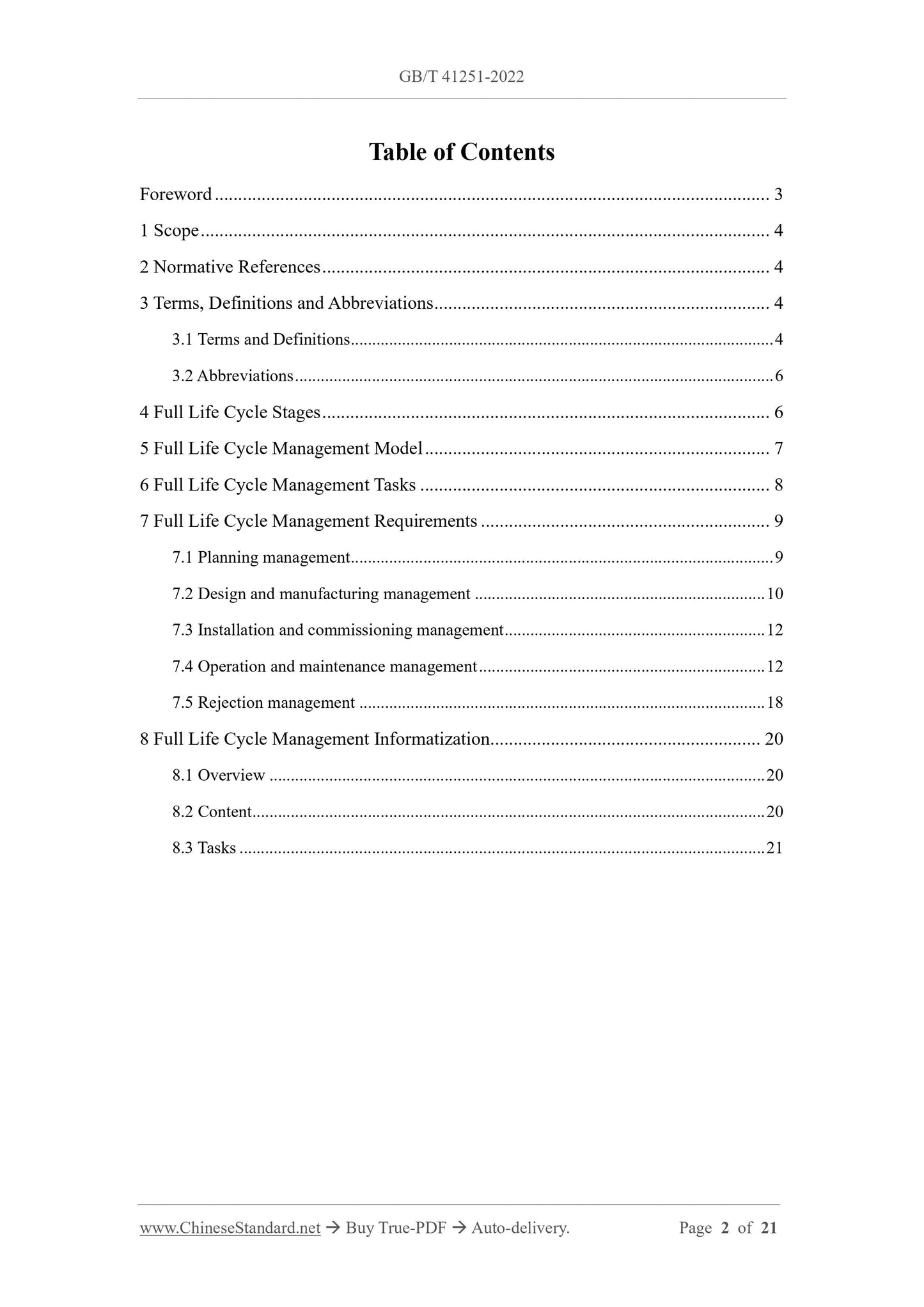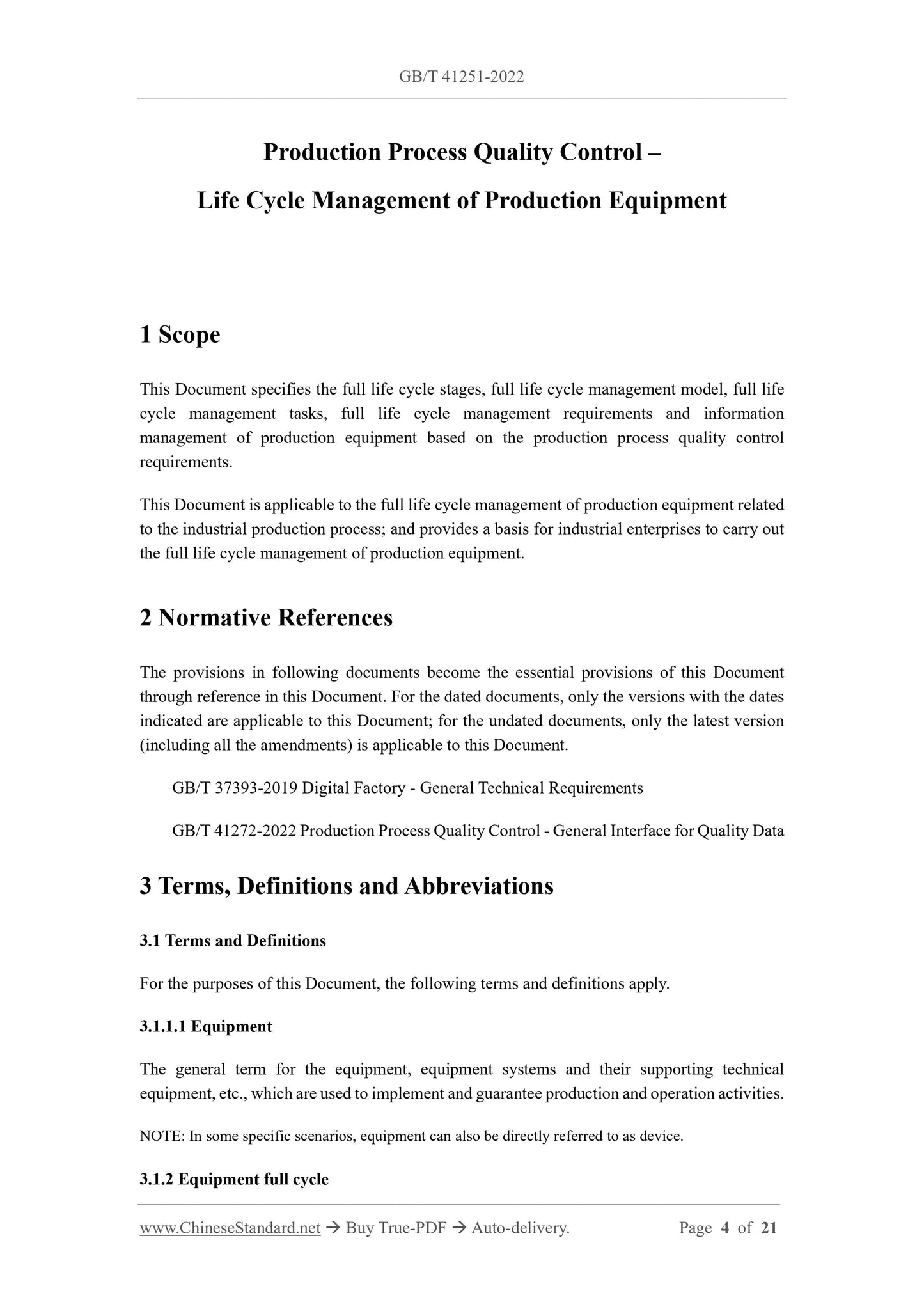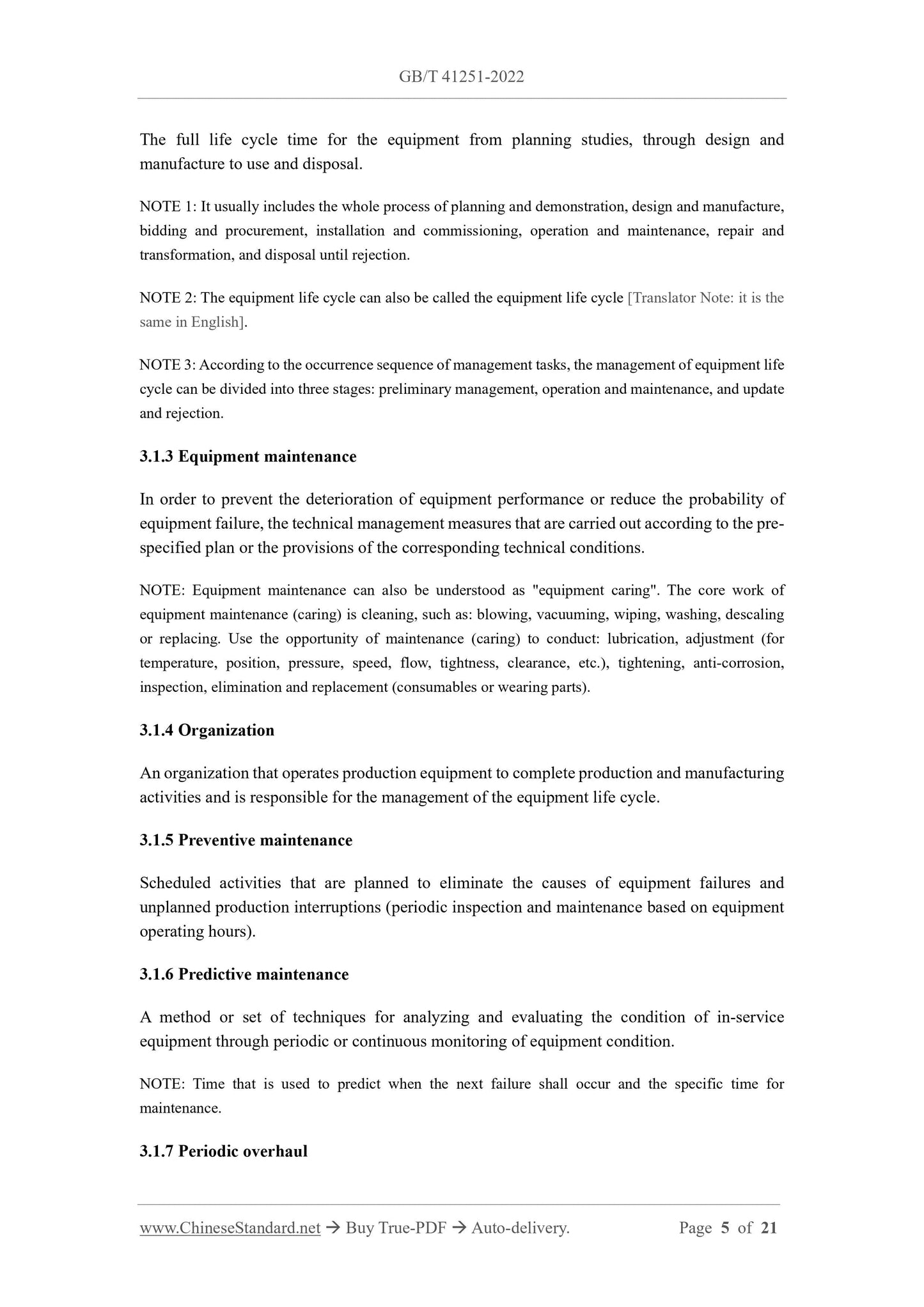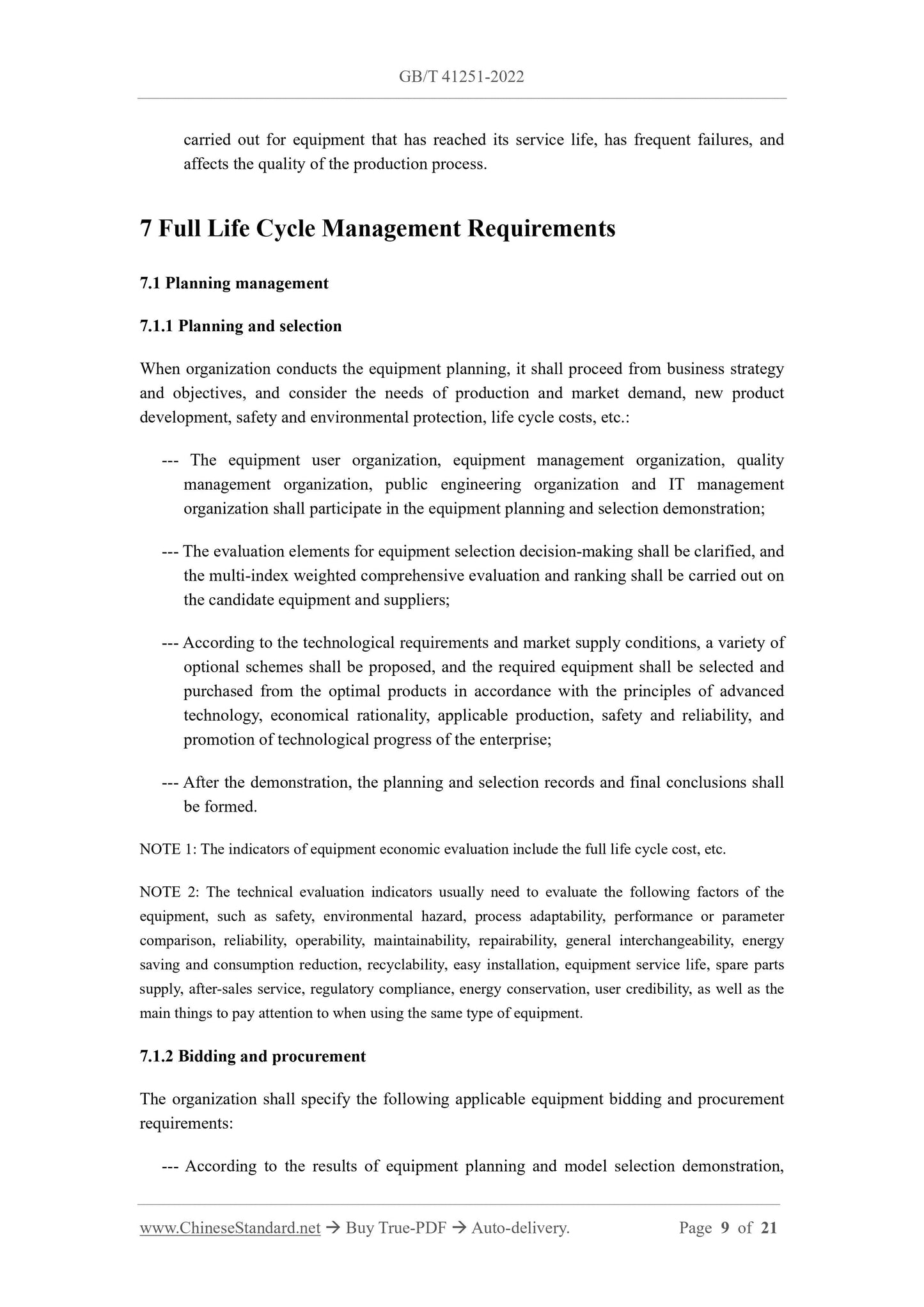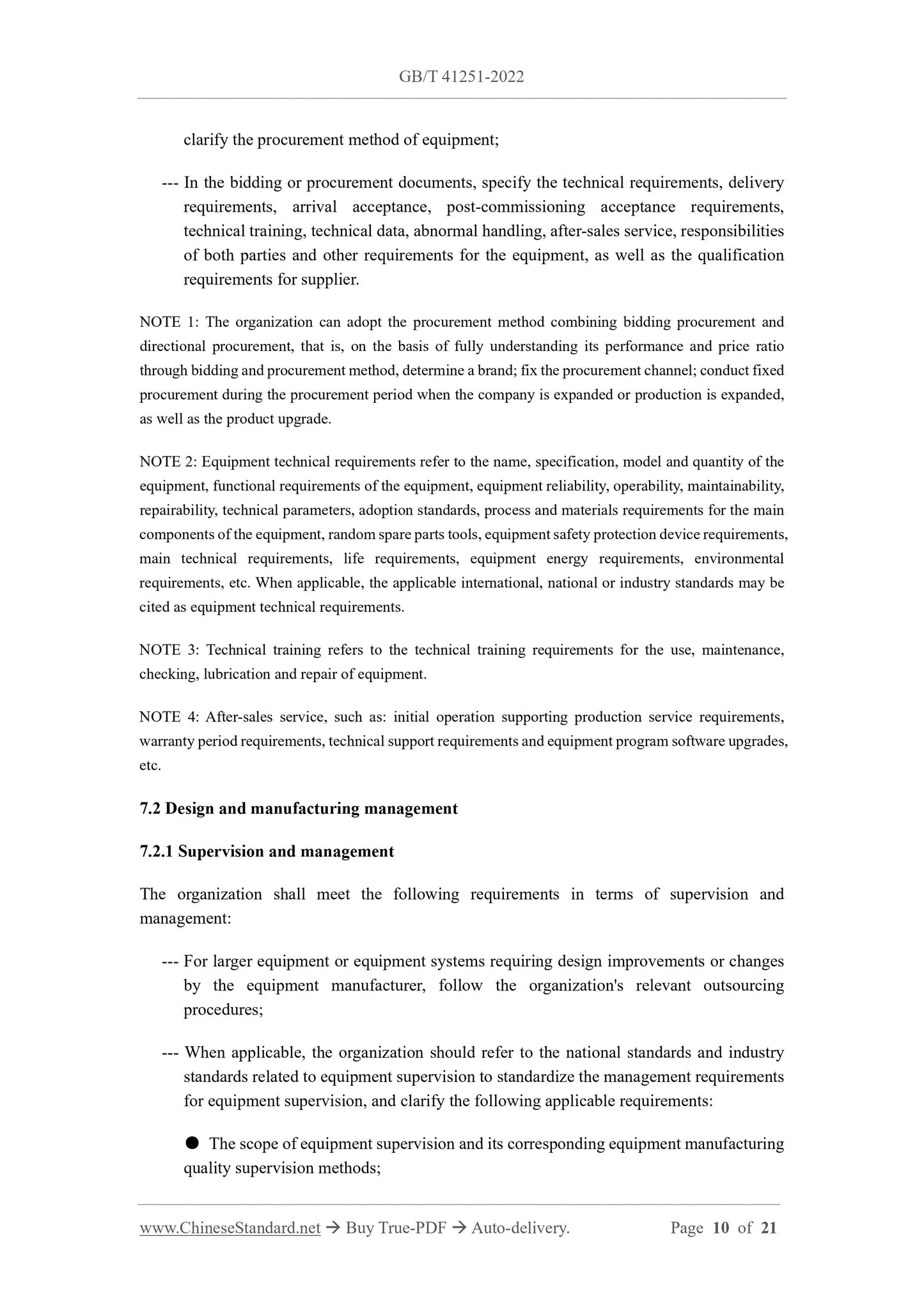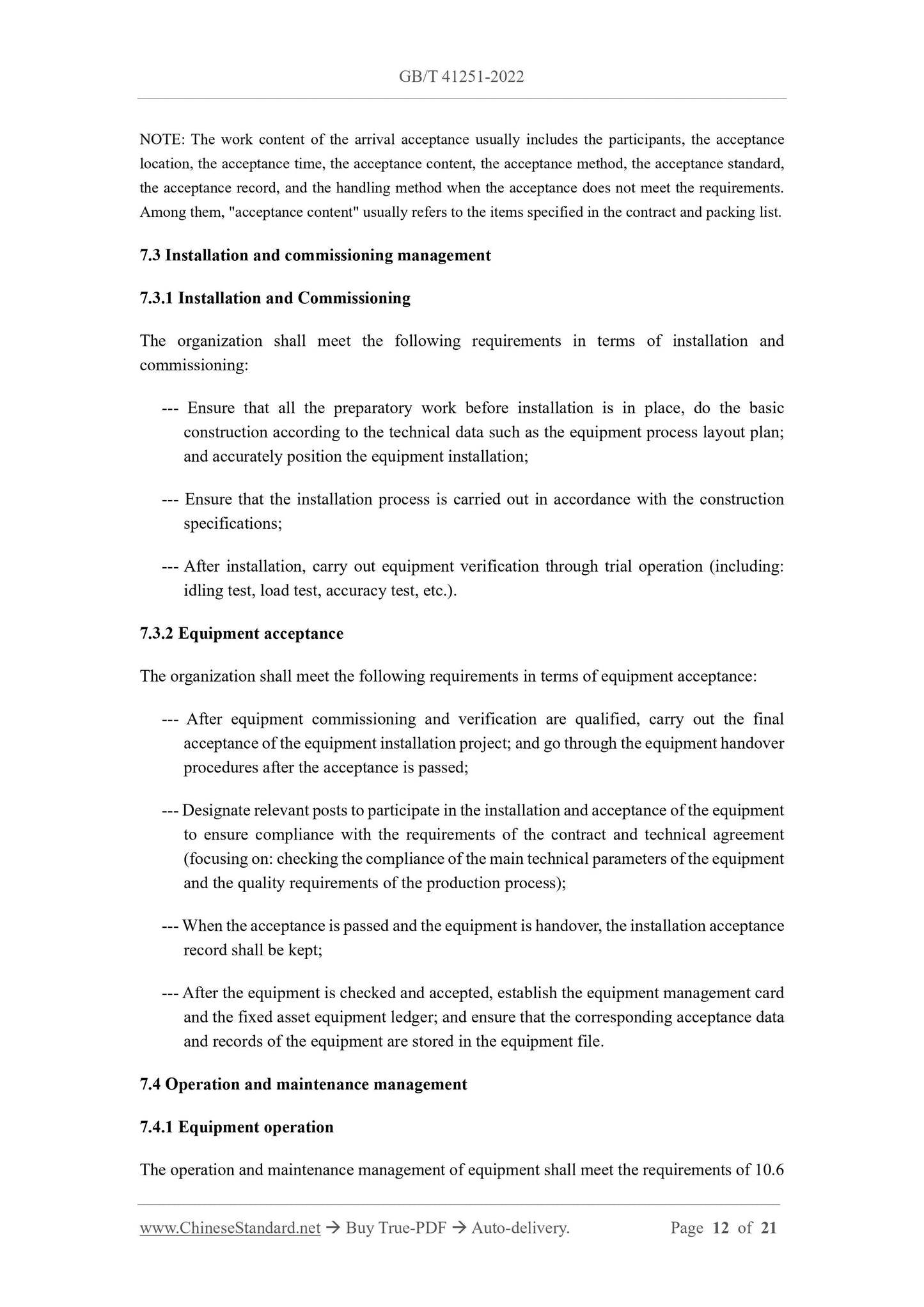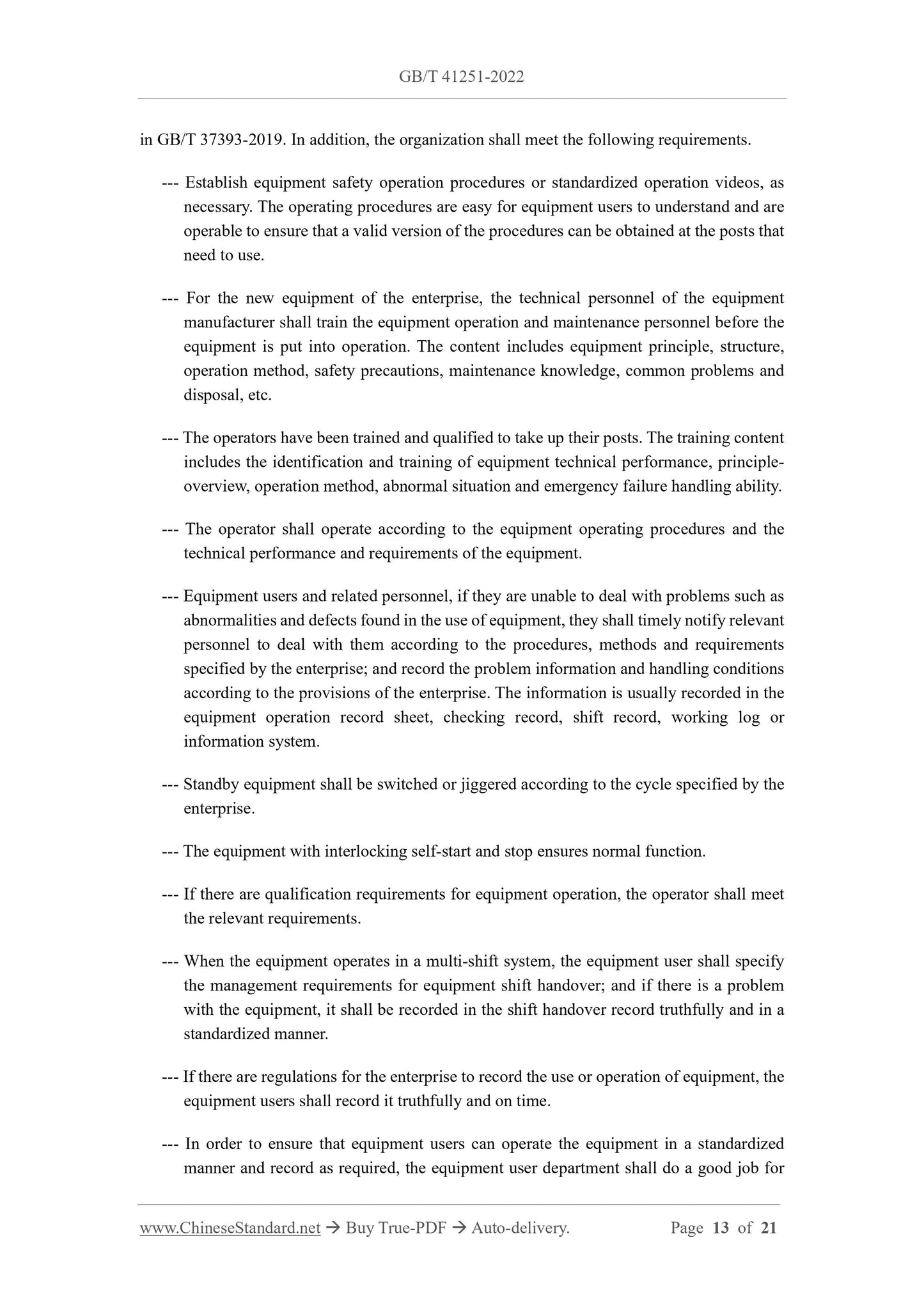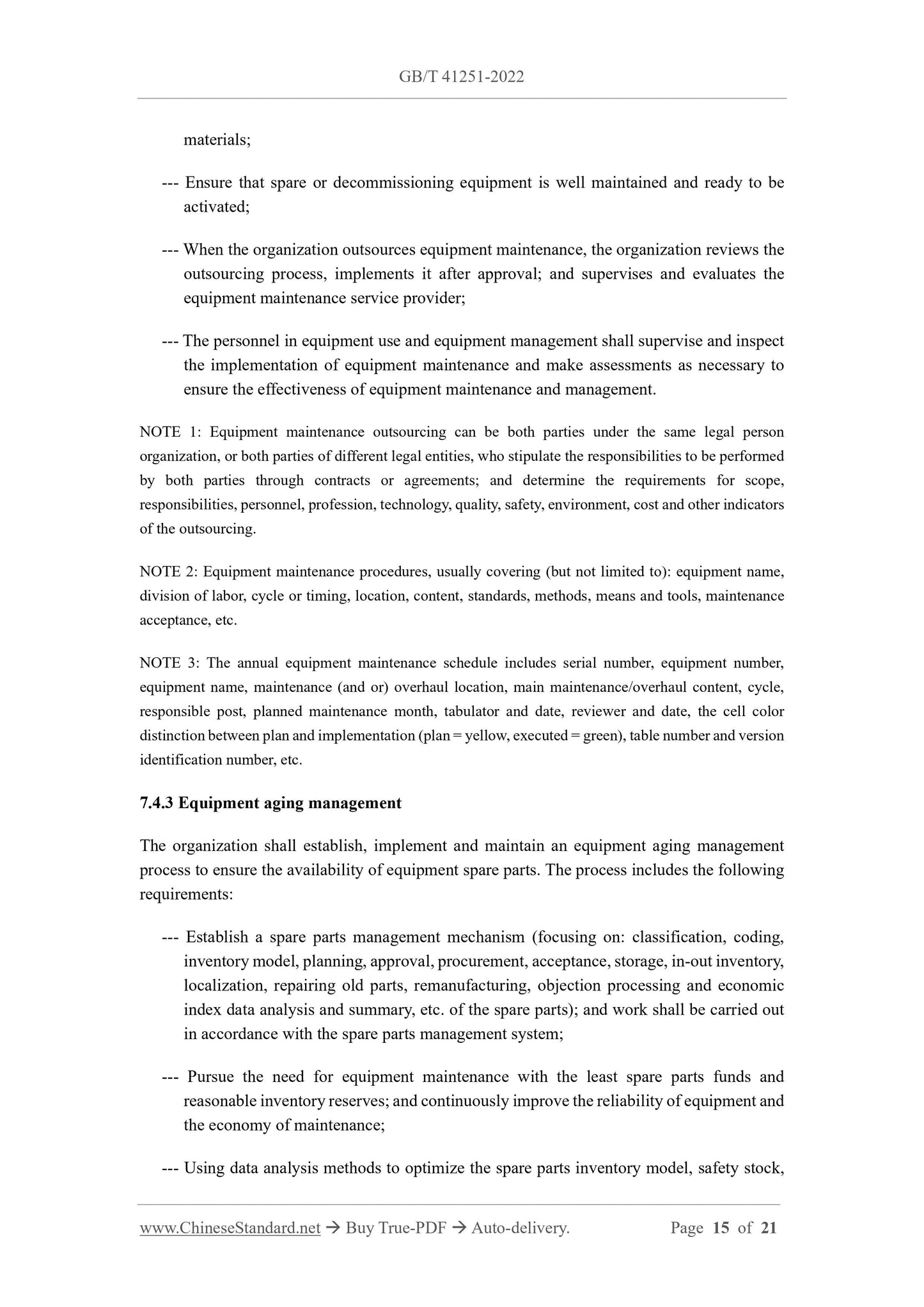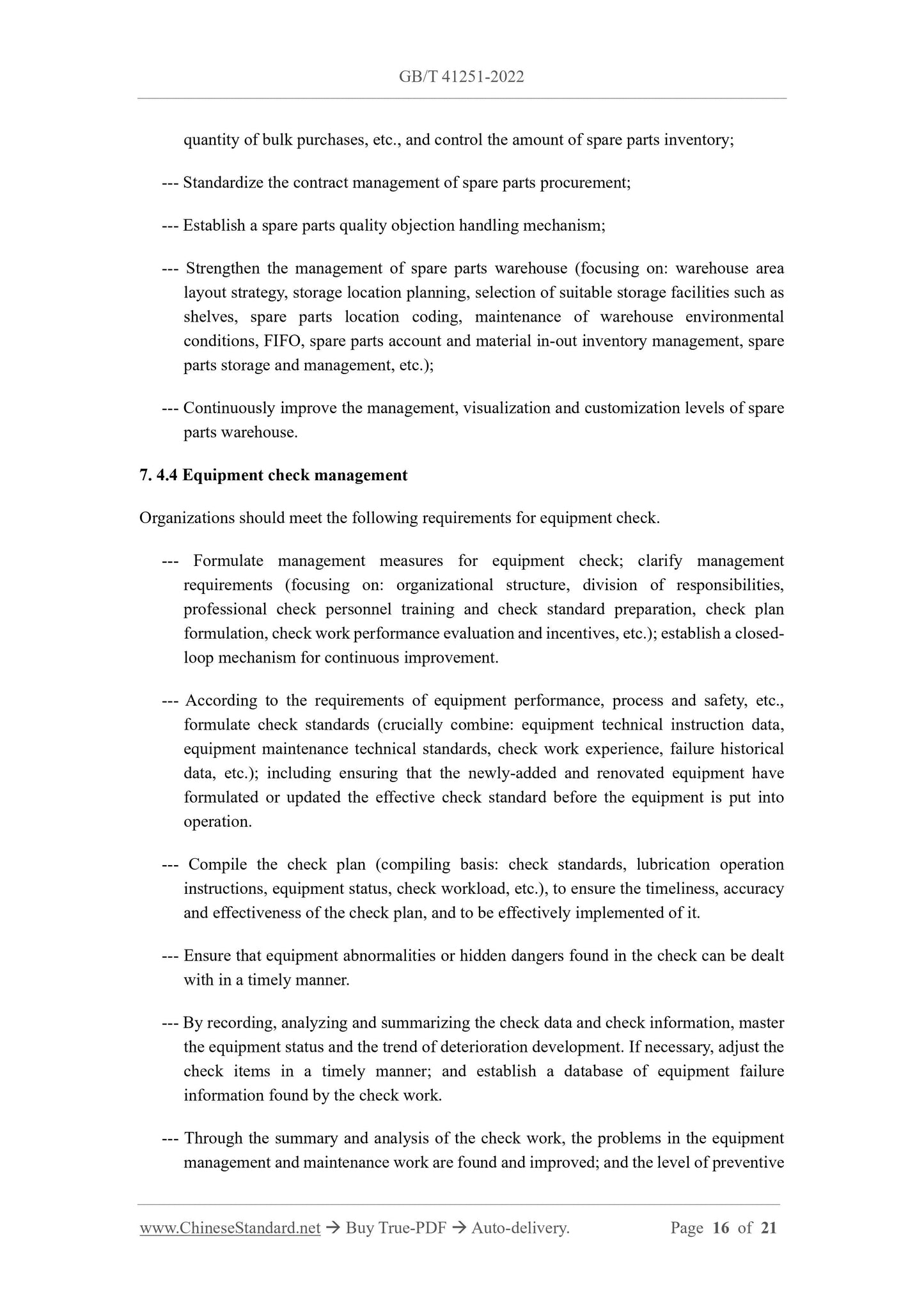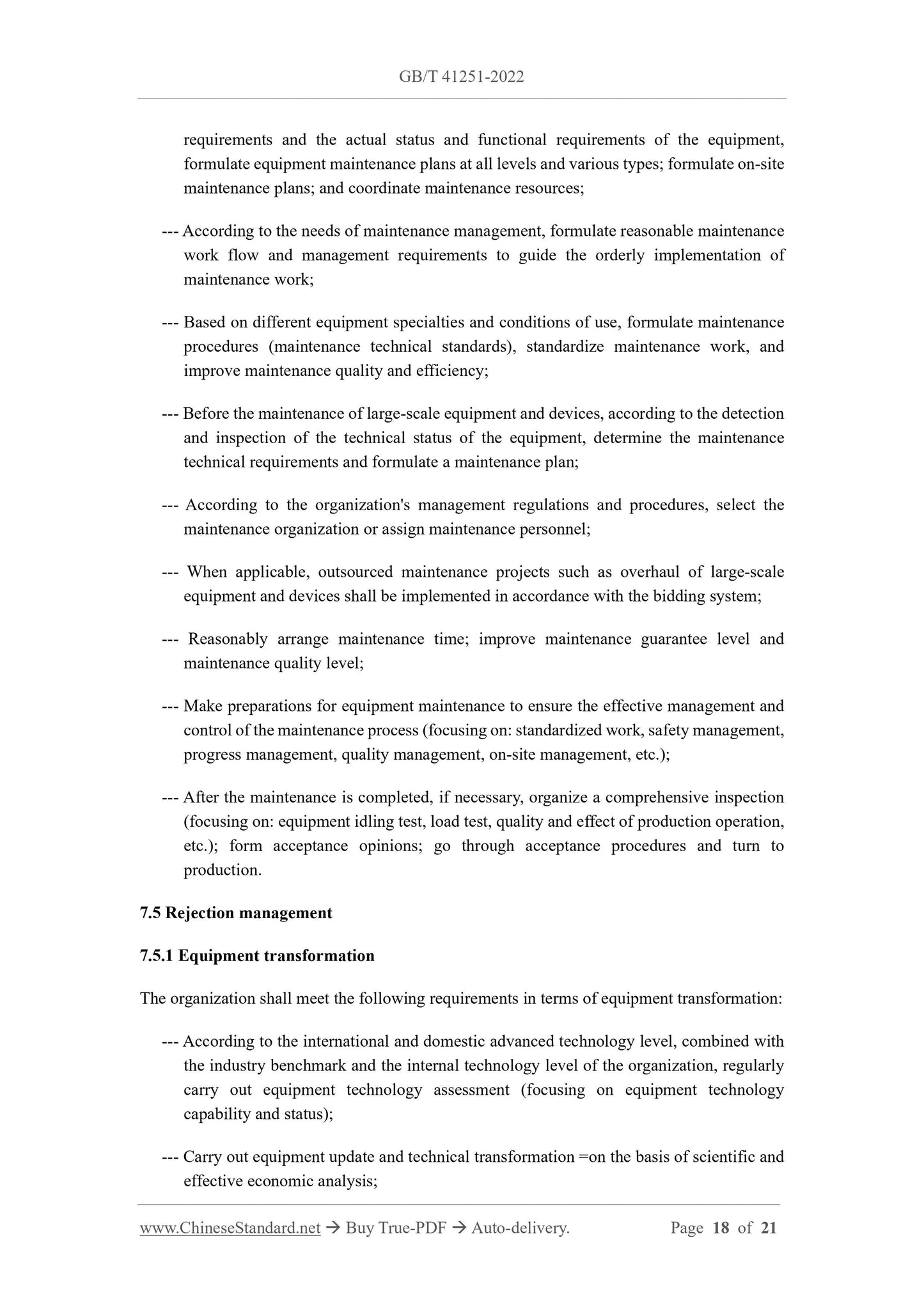1
/
of
11
PayPal, credit cards. Download editable-PDF and invoice in 1 second!
GB/T 41251-2022 English PDF (GBT41251-2022)
GB/T 41251-2022 English PDF (GBT41251-2022)
Regular price
$230.00 USD
Regular price
Sale price
$230.00 USD
Unit price
/
per
Shipping calculated at checkout.
Couldn't load pickup availability
Delivery: 3 seconds. Download true-PDF + Invoice.
Get QUOTATION in 1-minute: Click GB/T 41251-2022
Historical versions: GB/T 41251-2022
Preview True-PDF (Reload/Scroll if blank)
GB/T 41251-2022: Production process quality control - Life cyclemanagement of production equipment
GB/T 41251-2022
NATIONAL STANDARD OF THE
PEOPLE’S REPUBLIC OF CHINA
ICS 25.040
CCS N 19
Production Process Quality Control –
Life Cycle Management of Production Equipment
ISSUED ON: MARCH 09, 2022
IMPLEMENTED ON: OCTOBER 01, 2022
Issued by: State Administration for Market Regulation;
Standardization Administration of the People’s Republic of China.
Table of Contents
Foreword ... 3
1 Scope ... 4
2 Normative References ... 4
3 Terms, Definitions and Abbreviations ... 4
3.1 Terms and Definitions ... 4
3.2 Abbreviations ... 6
4 Full Life Cycle Stages ... 6
5 Full Life Cycle Management Model ... 7
6 Full Life Cycle Management Tasks ... 8
7 Full Life Cycle Management Requirements ... 9
7.1 Planning management ... 9
7.2 Design and manufacturing management ... 10
7.3 Installation and commissioning management ... 12
7.4 Operation and maintenance management ... 12
7.5 Rejection management ... 18
8 Full Life Cycle Management Informatization ... 20
8.1 Overview ... 20
8.2 Content ... 20
8.3 Tasks ... 21
Production Process Quality Control –
Life Cycle Management of Production Equipment
1 Scope
This Document specifies the full life cycle stages, full life cycle management model, full life
cycle management tasks, full life cycle management requirements and information
management of production equipment based on the production process quality control
requirements.
This Document is applicable to the full life cycle management of production equipment related
to the industrial production process; and provides a basis for industrial enterprises to carry out
the full life cycle management of production equipment.
2 Normative References
The provisions in following documents become the essential provisions of this Document
through reference in this Document. For the dated documents, only the versions with the dates
indicated are applicable to this Document; for the undated documents, only the latest version
(including all the amendments) is applicable to this Document.
GB/T 37393-2019 Digital Factory - General Technical Requirements
GB/T 41272-2022 Production Process Quality Control - General Interface for Quality Data
3 Terms, Definitions and Abbreviations
3.1 Terms and Definitions
For the purposes of this Document, the following terms and definitions apply.
3.1.1.1 Equipment
The general term for the equipment, equipment systems and their supporting technical
equipment, etc., which are used to implement and guarantee production and operation activities.
NOTE: In some specific scenarios, equipment can also be directly referred to as device.
3.1.2 Equipment full cycle
The full life cycle time for the equipment from planning studies, through design and
manufacture to use and disposal.
NOTE 1: It usually includes the whole process of planning and demonstration, design and manufacture,
bidding and procurement, installation and commissioning, operation and maintenance, repair and
transformation, and disposal until rejection.
NOTE 2: The equipment life cycle can also be called the equipment life cycle [Translator Note: it is the
same in English].
NOTE 3: According to the occurrence sequence of management tasks, the management of equipment life
cycle can be divided into three stages: preliminary management, operation and maintenance, and update
and rejection.
3.1.3 Equipment maintenance
In order to prevent the deterioration of equipment performance or reduce the probability of
equipment failure, the technical management measures that are carried out according to the pre-
specified plan or the provisions of the corresponding technical conditions.
NOTE: Equipment maintenance can also be understood as "equipment caring". The core work of
equipment maintenance (caring) is cleaning, such as: blowing, vacuuming, wiping, washing, descaling
or replacing. Use the opportunity of maintenance (caring) to conduct: lubrication, adjustment (for
temperature, position, pressure, speed, flow, tightness, clearance, etc.), tightening, anti-corrosion,
inspection, elimination and replacement (consumables or wearing parts).
3.1.4 Organization
An organization that operates production equipment to complete production and manufacturing
activities and is responsible for the management of the equipment life cycle.
3.1.5 Preventive maintenance
Scheduled activities that are planned to eliminate the causes of equipment failures and
unplanned production interruptions (periodic inspection and maintenance based on equipment
operating hours).
3.1.6 Predictive maintenance
A method or set of techniques for analyzing and evaluating the condition of in-service
equipment through periodic or continuous monitoring of equipment condition.
NOTE: Time that is used to predict when the next failure shall occur and the specific time for
maintenance.
3.1.7 Periodic overhaul
carried out for equipment that has reached its service life, has frequent failures, and
affects the quality of the production process.
7 Full Life Cycle Management Requirements
7.1 Planning management
7.1.1 Planning and selection
When organization conducts the equipment planning, it shall proceed from business strategy
and objectives, and consider the needs of production and market demand, new product
development, safety and environmental protection, life cycle costs, etc.:
--- The equipment user organization, equipment management organization, quality
management organization, public engineering organization and IT management
organization shall participate in the equipment planning and selection demonstration;
--- The evaluation elements for equipment selection decision-making shall be clarified, and
the multi-index weighted comprehensive evaluation and ranking shall be carried out on
the candidate equipment and suppliers;
--- According to the technological requirements and market supply conditions, a variety of
optional schemes shall be proposed, and the required equipment shall be selected and
purchased from the optimal products in accordance with the principles of advanced
technology, economical rationality, applicable production, safety and reliability, and
promotion of technological progress of the enterprise;
--- After the demonstration, the planning and selection records and final conclusions shall
be formed.
NOTE 1: The indicators of equipment economic evaluation include the full life cycle cost, etc.
NOTE 2: The technical evaluation indicators usually need to evaluate the following factors of the
equipment, such as safety, environmental hazard, process adaptability, performance or parameter
comparison, reliability, operability, maintainability, repairability, general interchangeability, energy
saving and consumption reduction, recyclability, easy installation, equipment service life, spare parts
supply, after-sales service, regulatory compliance, energy conservation, user credibility, as well as the
main things to pay attention to when using the same type of equipment.
7.1.2 Bidding and procurement
The organization shall specify the following applicable equipment bidding and procurement
requirements:
--- According to the results of equipment planning and model selection demonstration,
clarify the procurement method of equipment;
--- In the bidding or procurement documents, specify the technical requirements, delivery
requirements, arrival acceptance, post-commissioning acceptance requirements,
technical training, technical data, abnormal handli...
Get QUOTATION in 1-minute: Click GB/T 41251-2022
Historical versions: GB/T 41251-2022
Preview True-PDF (Reload/Scroll if blank)
GB/T 41251-2022: Production process quality control - Life cyclemanagement of production equipment
GB/T 41251-2022
NATIONAL STANDARD OF THE
PEOPLE’S REPUBLIC OF CHINA
ICS 25.040
CCS N 19
Production Process Quality Control –
Life Cycle Management of Production Equipment
ISSUED ON: MARCH 09, 2022
IMPLEMENTED ON: OCTOBER 01, 2022
Issued by: State Administration for Market Regulation;
Standardization Administration of the People’s Republic of China.
Table of Contents
Foreword ... 3
1 Scope ... 4
2 Normative References ... 4
3 Terms, Definitions and Abbreviations ... 4
3.1 Terms and Definitions ... 4
3.2 Abbreviations ... 6
4 Full Life Cycle Stages ... 6
5 Full Life Cycle Management Model ... 7
6 Full Life Cycle Management Tasks ... 8
7 Full Life Cycle Management Requirements ... 9
7.1 Planning management ... 9
7.2 Design and manufacturing management ... 10
7.3 Installation and commissioning management ... 12
7.4 Operation and maintenance management ... 12
7.5 Rejection management ... 18
8 Full Life Cycle Management Informatization ... 20
8.1 Overview ... 20
8.2 Content ... 20
8.3 Tasks ... 21
Production Process Quality Control –
Life Cycle Management of Production Equipment
1 Scope
This Document specifies the full life cycle stages, full life cycle management model, full life
cycle management tasks, full life cycle management requirements and information
management of production equipment based on the production process quality control
requirements.
This Document is applicable to the full life cycle management of production equipment related
to the industrial production process; and provides a basis for industrial enterprises to carry out
the full life cycle management of production equipment.
2 Normative References
The provisions in following documents become the essential provisions of this Document
through reference in this Document. For the dated documents, only the versions with the dates
indicated are applicable to this Document; for the undated documents, only the latest version
(including all the amendments) is applicable to this Document.
GB/T 37393-2019 Digital Factory - General Technical Requirements
GB/T 41272-2022 Production Process Quality Control - General Interface for Quality Data
3 Terms, Definitions and Abbreviations
3.1 Terms and Definitions
For the purposes of this Document, the following terms and definitions apply.
3.1.1.1 Equipment
The general term for the equipment, equipment systems and their supporting technical
equipment, etc., which are used to implement and guarantee production and operation activities.
NOTE: In some specific scenarios, equipment can also be directly referred to as device.
3.1.2 Equipment full cycle
The full life cycle time for the equipment from planning studies, through design and
manufacture to use and disposal.
NOTE 1: It usually includes the whole process of planning and demonstration, design and manufacture,
bidding and procurement, installation and commissioning, operation and maintenance, repair and
transformation, and disposal until rejection.
NOTE 2: The equipment life cycle can also be called the equipment life cycle [Translator Note: it is the
same in English].
NOTE 3: According to the occurrence sequence of management tasks, the management of equipment life
cycle can be divided into three stages: preliminary management, operation and maintenance, and update
and rejection.
3.1.3 Equipment maintenance
In order to prevent the deterioration of equipment performance or reduce the probability of
equipment failure, the technical management measures that are carried out according to the pre-
specified plan or the provisions of the corresponding technical conditions.
NOTE: Equipment maintenance can also be understood as "equipment caring". The core work of
equipment maintenance (caring) is cleaning, such as: blowing, vacuuming, wiping, washing, descaling
or replacing. Use the opportunity of maintenance (caring) to conduct: lubrication, adjustment (for
temperature, position, pressure, speed, flow, tightness, clearance, etc.), tightening, anti-corrosion,
inspection, elimination and replacement (consumables or wearing parts).
3.1.4 Organization
An organization that operates production equipment to complete production and manufacturing
activities and is responsible for the management of the equipment life cycle.
3.1.5 Preventive maintenance
Scheduled activities that are planned to eliminate the causes of equipment failures and
unplanned production interruptions (periodic inspection and maintenance based on equipment
operating hours).
3.1.6 Predictive maintenance
A method or set of techniques for analyzing and evaluating the condition of in-service
equipment through periodic or continuous monitoring of equipment condition.
NOTE: Time that is used to predict when the next failure shall occur and the specific time for
maintenance.
3.1.7 Periodic overhaul
carried out for equipment that has reached its service life, has frequent failures, and
affects the quality of the production process.
7 Full Life Cycle Management Requirements
7.1 Planning management
7.1.1 Planning and selection
When organization conducts the equipment planning, it shall proceed from business strategy
and objectives, and consider the needs of production and market demand, new product
development, safety and environmental protection, life cycle costs, etc.:
--- The equipment user organization, equipment management organization, quality
management organization, public engineering organization and IT management
organization shall participate in the equipment planning and selection demonstration;
--- The evaluation elements for equipment selection decision-making shall be clarified, and
the multi-index weighted comprehensive evaluation and ranking shall be carried out on
the candidate equipment and suppliers;
--- According to the technological requirements and market supply conditions, a variety of
optional schemes shall be proposed, and the required equipment shall be selected and
purchased from the optimal products in accordance with the principles of advanced
technology, economical rationality, applicable production, safety and reliability, and
promotion of technological progress of the enterprise;
--- After the demonstration, the planning and selection records and final conclusions shall
be formed.
NOTE 1: The indicators of equipment economic evaluation include the full life cycle cost, etc.
NOTE 2: The technical evaluation indicators usually need to evaluate the following factors of the
equipment, such as safety, environmental hazard, process adaptability, performance or parameter
comparison, reliability, operability, maintainability, repairability, general interchangeability, energy
saving and consumption reduction, recyclability, easy installation, equipment service life, spare parts
supply, after-sales service, regulatory compliance, energy conservation, user credibility, as well as the
main things to pay attention to when using the same type of equipment.
7.1.2 Bidding and procurement
The organization shall specify the following applicable equipment bidding and procurement
requirements:
--- According to the results of equipment planning and model selection demonstration,
clarify the procurement method of equipment;
--- In the bidding or procurement documents, specify the technical requirements, delivery
requirements, arrival acceptance, post-commissioning acceptance requirements,
technical training, technical data, abnormal handli...
Share
